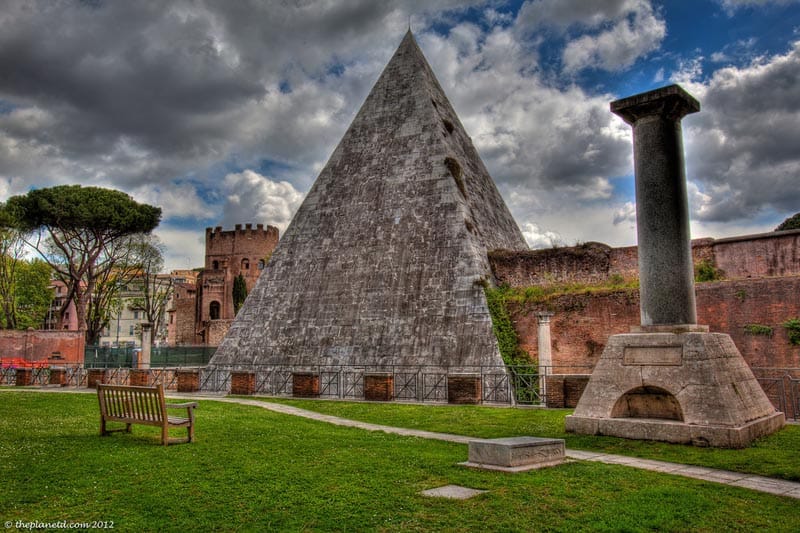The Protestant Cemetery of Rome, also known as The Non-Catholic Cemetery for Foreigners, is a lovely escape from the hustle and bustle of the city.
Like the Pere Lachaise Cemetery in Paris, the Protestant Cemetery of Rome is filled with beautiful tombstones and famous residents.
Protestant Cemetery in Rome
The Non-Catholic Cemetery for Foreigners claims to have the highest density of famous and important graves anywhere in the world. While many cemeteries may rival Rome’s claim to fame, the cemetery’s impressive collection cannot be denied.
Famous Residents of the Protestant Cemetery, Rome
The most renowned resident of the Protestant Cemetery in Rome is the poet John Keats. His tragic story comes to a bitter end in this serene resting place. Suffering from tuberculosis, his doctors recommended he go to Rome to take advantage of the Mediterranean climate. Sadly, he only survived for four months before succumbing to his disease.
Regrettably, Keats was never acknowledged as a significant poet during his brief life; neither the critics nor the public embraced his work. Consequently, it tormented him to be dying at the young age of 25 without the chance for recognition, resulting in his final wish for his name to be omitted from the gravestone.
Instead, John Keats’ epitaph reads:
“This Grave contains all that was Mortal of a YOUNG ENGLISH POET” “Here Lies the One Whose Name was Writ in Water”
Interestingly, he is buried alongside Joseph Severn, who passed away roughly 50 years later. Severn was with Keats on his deathbed, and some believe he pays tribute to his friend by stating on his own epitaph: “Devoted friend and deathbed companion of John Keats.” However, others argue that he was a name-dropper, needing to associate himself with fame even in death.
Looking closely at the grave of Severn’s son just behind the Keats and Severn graves, one can draw their own conclusions. The inscription states: “The infant son of Joseph Severn… accidentally killed in 1837. The poet Wordsworth was present at his baptism.” This raises the question of whether Severn was, in fact, a name-dropper.
After all, Keats didn’t want his name inscribed on his tombstone; he sought obscurity, while his friend Severn chose to highlight his connection to Keats on his own tomb.
Poet Percy Bysshe Shelley
Keats isn’t the only illustrious poet in Rome’s Protestant Cemetery. Percy Bysshe Shelley, husband of Mary Shelley of Frankenstein fame, is also interred here. Although he was not suffering from a disease, he tragically died at the young age of 29.
Living life on the edge, Shelley set sail even after warnings of an imminent storm. “Don’t go out to sea,” they said, “you’ll die.” Unfortunately, he did not heed their advice and met his demise.
Fittingly, a verse from Shakespeare’s The Tempest is inscribed on his grave:
“Nothing of him that doth fade, But doth suffer a sea-change Into something rich and strange.”
Ancient Tombs in the Protestant Cemetery
One of the most striking tombs in the cemetery dates back to 12 BC. At 36 meters high, it is indeed an unexpected site. Caius Cestius, a magistrate of ancient Rome, had this tomb constructed for himself during a period when everything Egyptian was fashionable in Rome.
According to our guide Kenny, Cestius was opposed to slavery—yet he employed slaves for the 330 days it took to finish his tomb. Moreover, after Cestius’ death, it became evident that he wasn’t as wealthy as he had appeared, leading to a lack of funds for the construction of the pyramid. Instead of interring his body within the tomb, it was discarded into the Tiber River.
There are numerous famous and significant tombs within the cemetery, making it a delightful stroll through Rome’s vibrant history. Therefore, it serves as a serene escape from the chaotic city, and this oasis in the Testaccio area should not be overlooked.
Visitor Information
Location of the Protestant or Non-Catholic Cemetery:
Via Caio Cestio, 6 Rome
00153 Roma
Opening hours:
Monday-Saturday from 9:00 AM to 5:00 PM (last entrance: 4:30 PM)
Sundays and public holidays from 9:00 AM to 1:00 PM (last entrance: 12:30 PM)




